|
|
|
Grand Tourer |
|
The GT versions of the Falcon are probably the most famous of the breed, and certainly the most desirable and collectable today. Quite what inspired Ford of Australia to produce such a car can be reduced to a single word: Bathurst. In its early years, the annual 500 mile race at the mountain road course of Mount Panorama, Bathurst attracted many entrants driving a wide variety of foreign and domestic cars, including the first purpose built local Ford ‘race’ car, the Cortina GT500. In 1967, however, Ford were keen to showcase their current image car, the Falcon, and with the arrival of the XR model, which for the first time in the Australian Falcon was available with a V8 engine, they set about planning something different. In many respects, the development of the XR GT benefitted from the gathering of several happy coincidences. First was having the right men at the right place. Bill Bourke was the then Assistant General Manager of Ford Australia and he was passionate about racing, and, inspired by the success of racing V8s, both in Australia and in his native U.S. he felt sure that a sporting XR Falcon could be a winner. He passed the idea over to Harry Firth, who was Ford’s tuner and race car preparer and had been so successful in developing the GT500 Cortina and who had been working on beefing up the XR after a request from the Victorian police for a heavy duty pursuit vehicle. Firth saw that, taking the best bits from the police package and introducing some more horsepower in the engine, a sporting Falcon GT could be developed. At the same time, the news and media, especially live television, were focussing on the annual Bathurst event and creating a valuable and unique advertising opportunity for any manufacturer willing and able to win the race by lasting the 500 miles. And finally, Henry Ford II, had set Ford on its ‘Total Performance’ track. Motor sport dominance was his aim. If in the U.S. that meant Nascar and the dragstrips, and in Europe it meant forest rallying and Le Mans, in Australia it meant touring cars and conquering the Mountain. |
|
XR GT |
|||
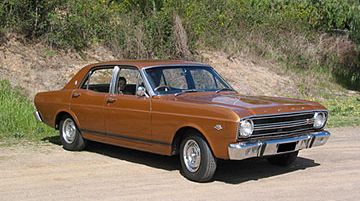 |
|||
|
Introduced in May, 1967 the all gold XR GT was a bombshell on the Australian motoring scene. Fitted with a 289ci (4.7litre) V8 engine with a four barrel carburettor, low restriction exhaust manifolds and raised compression ratio, the engine developed 225hp, and coupled with the tall 2.92:1 axle ratio, the car was capable of 120mph. The suspension was re-rated and a full set of instrumentation was fitted. Ford needed to build 201 to satisfy the motorsport’s governing body that it was a production car. In the end they produced 684. |
|
XT GT |
||||||||||||||||||||||||||||||||||
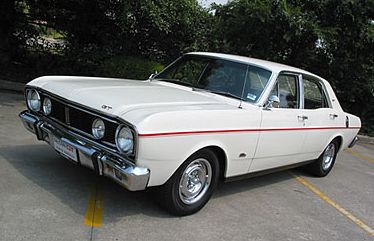 |
||||||||||||||||||||||||||||||||||
|
Introduced in May, 1968, the XT GT was a continuation of the theme although it was available in a greater range of colours, and introduced driving lights to the grille, a feature that was to become a trademark for all subsequent GTs. Mechanical changes were made too, engine size increasing to 302ci (4.9litres) raising power output to 230hp, and a limited slip axle was available to put the power to the ground. Wider tyres and revisions to the suspension made the XT a taughter, but more comfortable drive than its predecessor. 1415 XT GTs were produced. |
||||||||||||||||||||||||||||||||||
|
XW GT |
||||||||||||||||||||||||||||||||||
 |
||||||||||||||||||||||||||||||||||
|
Introduced in June, 1969, the XW represented further cosmetic revisions to the original XR, but Ford saved the big news for under the bonnet. Determined to overpower the opposition, they installed the big 351ci (5.7litre) Windsor V8 producing 290hp. Brakes and clutch were uprated, and a scoop introduced to direct air to the brake master cylinder. The famous ‘Super Roo’ stickers adorned the front wings and became the advertising motif for the car. While the car was fast, the racers demanded more and in August, 1969 Ford released the GT-HO where HO stood for Handling Option and brought a host of engine, brake and suspension tweaks to satisfy the race teams. The distinguishing feature of the HO was the front under bumper spoiler. In early 1970, Ford made a running change to the XW GT, replacing the 351ci Windsor engine with the more modern 351ci Cleveland. GT-HOs were fitted with this engine too, but in July, 1970,the HO received many more heavy duty parts from Ford’s racing department and became known as the Phase 2. Retrospectively, the Windsor GT-HO became the Phase 1, and the original Cleveland powered car became known as the Phase 1.5. 2287 XW GTs were produced, 260 GT-HO Phase1’s, 110 GT-HO Phase1.5’s and 292 GT-HO Phase 2s. |
||||||||||||||||||||||||||||||||||
|
XY GT |
||||||||||||||||||||||||||||||||||
 |
||||||||||||||||||||||||||||||||||
|
Introduced in late 1970, the XY was the last revamp of the XR bodystyle and featured minor tweaking of the front and rear ends. What remained the same was the 351ci (5.8litre) Cleveland V8 except this time it was fitted with the Mustang developed Shaker bonnet scoop, so named because it was was attached to the engine and shook when the engine idled. Following the trend set with the XW, it did not take Ford long to unveil their homologation race car, the GT-HO Phase 3. Distinguished from the outside by its front spoiler and boot mounted wing, the Phase 3 was heavily modified mechanically and, in the era when stock racing cars had to be stock showroom cars, it was as close to an off the peg race car that you could buy. For many years regarded as the fastest four door car in the world, and rumoured to have 380hp on tap, the Phase 3 was an instant classic, a legend in its own time and ever since. 1557 XY GTs were produced, and 300 GT-HO Phase 3s. |
||||||||||||||||||||||||||||||||||
|
XA GT |
||||||||||||||||||||||||||||||||||
 |
||||||||||||||||||||||||||||||||||
|
Introduced in March, 1972 in four door form, for the first time ever, the GT was also available as a two door hardtop coupe introduced in August, 1972. |
||||||||||||||||||||||||||||||||||
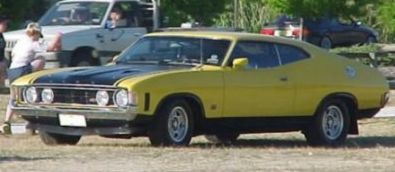 |
||||||||||||||||||||||||||||||||||
|
The XA GT was the first Australian designed Ford, and the GT version was a much more refined car than its predecessors which had been designed more as road going race cars than true Grand Tourers. Ford hoped to change this with the XA, but in so doing lost some of the raw appeal that had endeared the XR-XY to the public. The XAs were undeniably good cars, but, although fitted with the same 351ci Cleveland V8, appeared not to be as quick. Ford, however, had a plan and waiting in the wings was the four door XA Phase 4. Sadly, a wave of media hysteria over Super Cars and government interference led to the cancelation of the new HO. Whatever the perception was of the road going XA GT’s performance, in racing hardtop guise, it remains the only Falcon to win twice at Bathurst. 1868 XA GT four doors were produced, and 891 hardtops. |
||||||||||||||||||||||||||||||||||
|
XB GT |
||||||||||||||||||||||||||||||||||
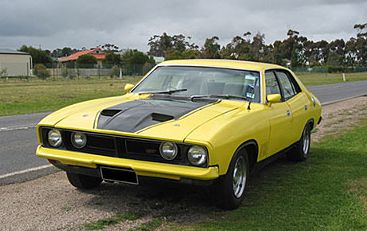 |
||||||||||||||||||||||||||||||||||
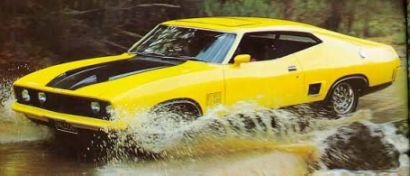 |
||||||||||||||||||||||||||||||||||
|
Introduced in September, 1973 the XB offered a minor but succesful restyling of the XA,with its colour keyed bumpers and recessed grille offering a cleaner and tidier presentation. The 351ci engine remained, now solely manufactured in Australia rather than imported and in a major development, four wheel disk brakes were fitted as standard. The XB ran out the GT line, existing until June, 1976 after which there were no more GTs. While it suffered from falling performance at the hands of emission regulations, it excelled in the Grand Tourer role, being comfortable and refined, with good handling, great brakes and V8 performance. 1950 four doors were produced, and 949 hardtops. |
||||||||||||||||||||||||||||||||||
|
Thanks to the Falcon GT Club of Australia for the pictures of their members cars on this page. |
||||||||||||||||||||||||||||||||||
|
More GT pictures here. |
||||||||||||||||||||||||||||||||||
|
Interested in the GT badges ? Here they are. |
||||||||||||||||||||||||||||||||||
|
[Australian Ford Register UK] [History] [The Cars] [XK - XP] [XR - XY] [XA - XC] [XD - XF] [Utes and Vans] [GT] [Fairlane] [LTD] [Specials] [Members] [Bits and Pieces] [Bits and Pieces 2] [Untitled124] [Links] [Visitors] [Events] [AusCCA] [Site History] |